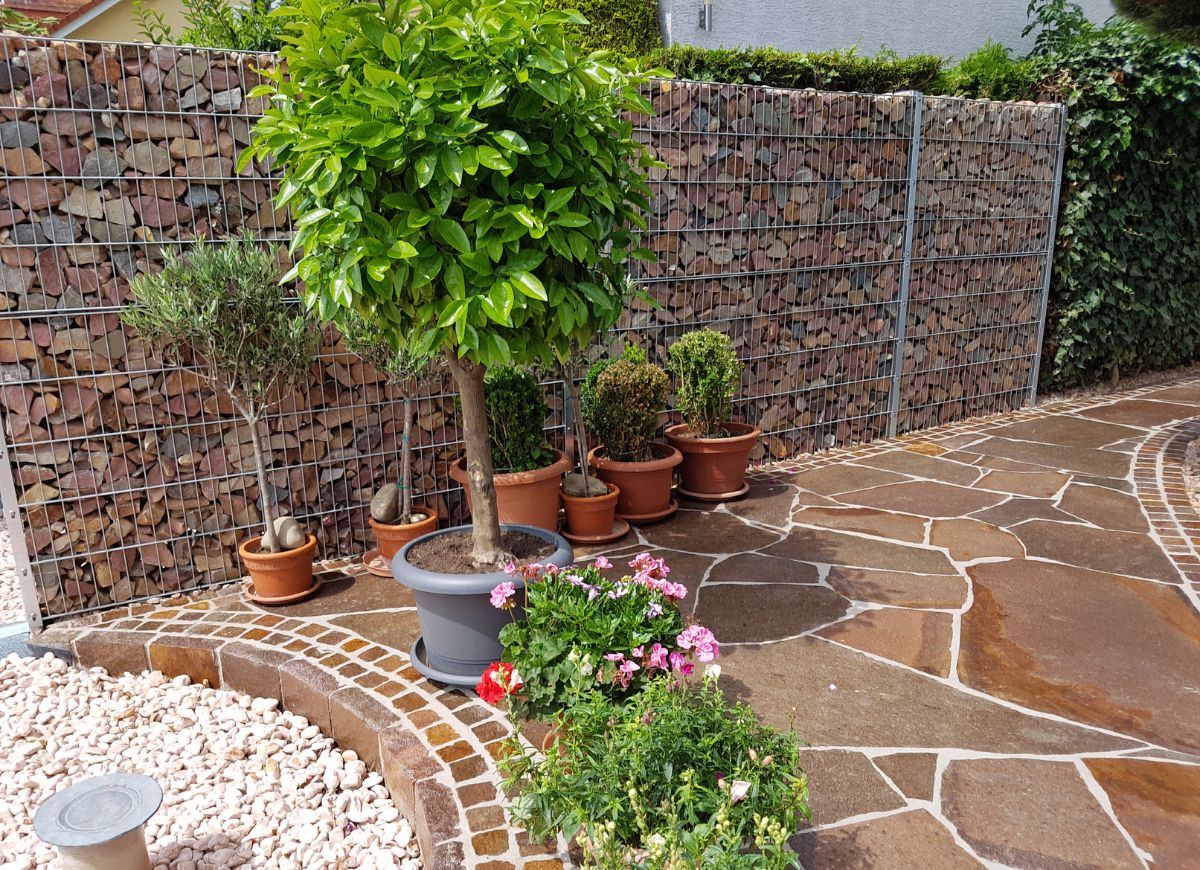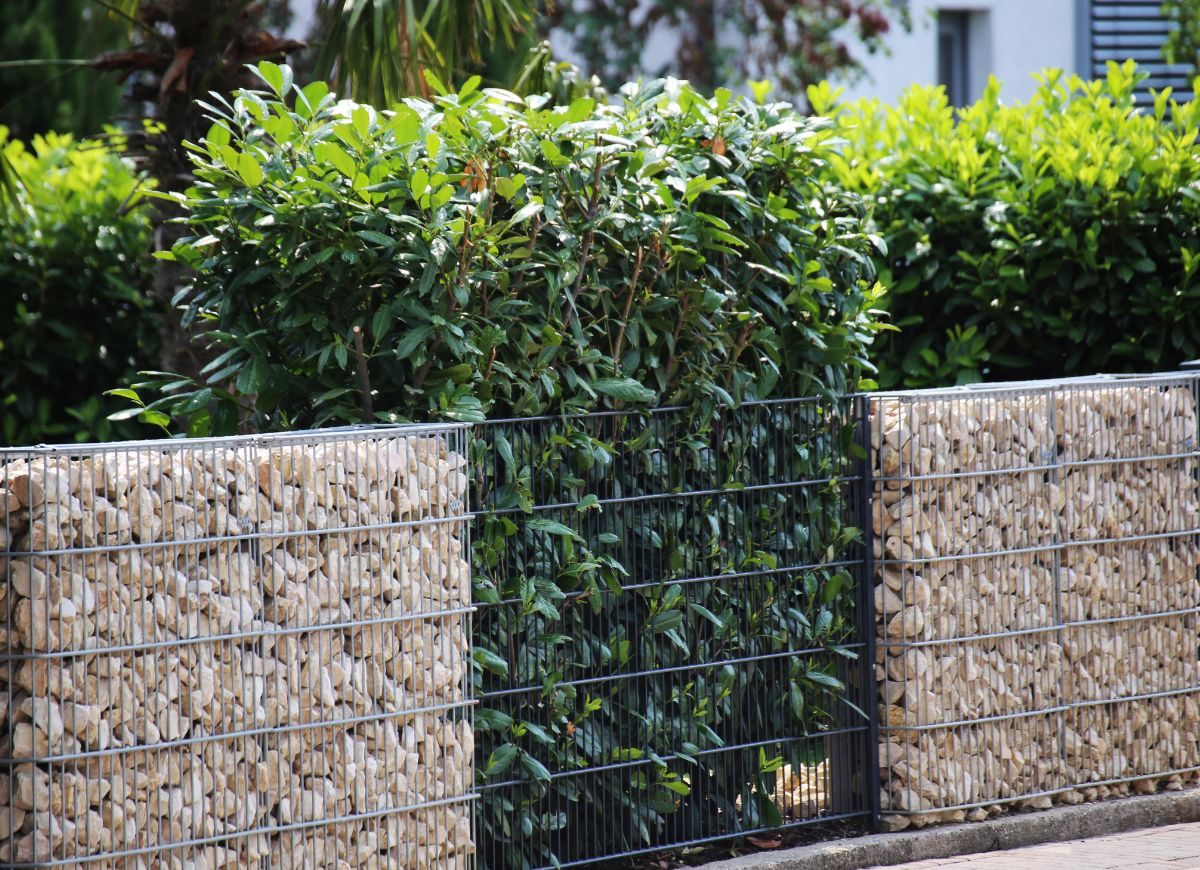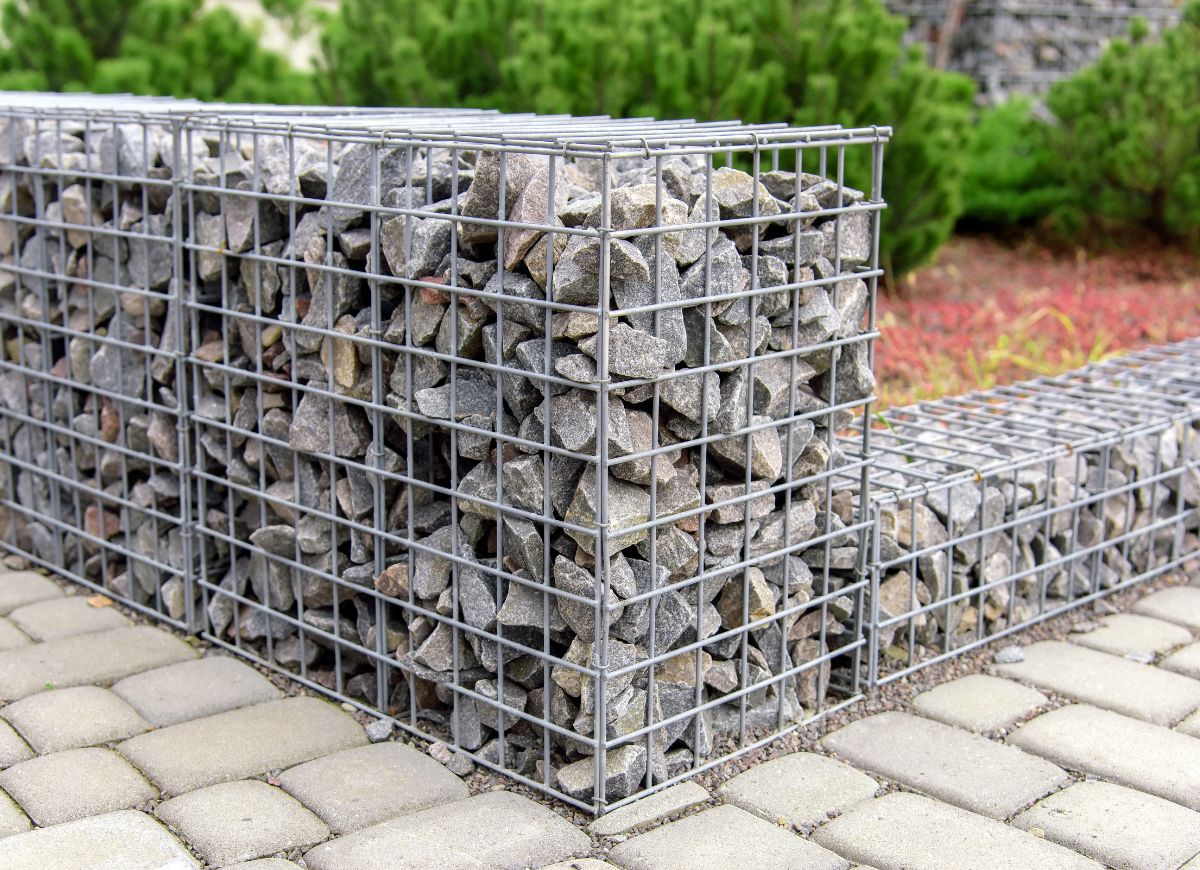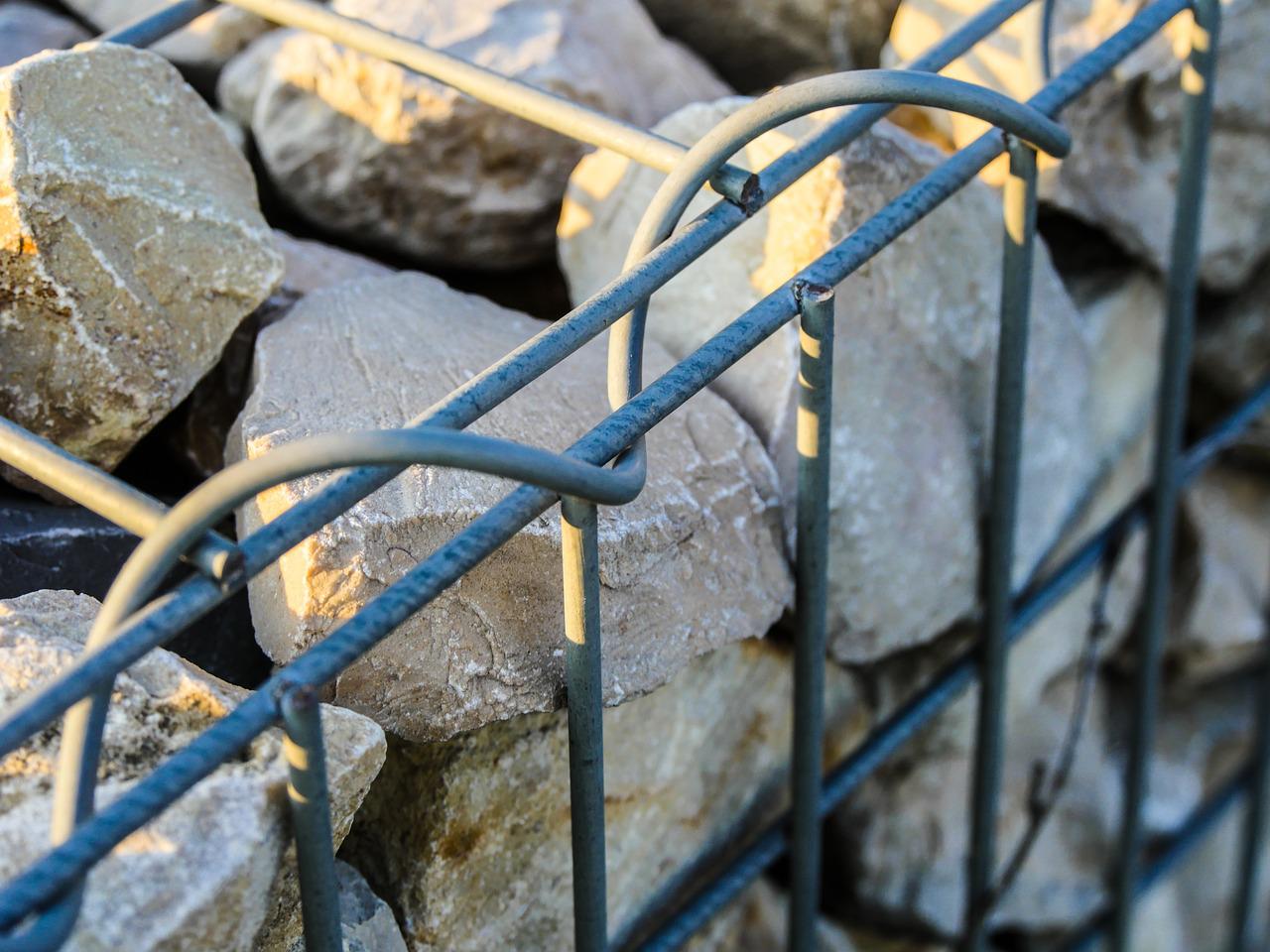

We may earn revenue from the products available on this page and participate in affiliate programs. Learn More ›
A gabion wall offers numerous home landscaping possibilities: They can serve as a budget-friendly retaining wall, enhance a home’s natural landscaping, or even be used as a privacy fence. Rather than being built using large stones or bricks, gabion walls are made by filling large baskets or cages with loose gravel, stones, or other heavy items.
While there are benefits to building a gabion wall on your property, there are also a few potential drawbacks to consider before making any final decisions. To determine if this landscaping feature is right for you, read on to learn more about gabion walls.
RELATED: The Dos and Don’ts of Building Retaining Walls
What Is a Gabion Wall?
Gabion is derived from gabbione, an Italian word meaning “big cage.” Gabion walls are made up of gabions, or large cages or baskets, which are filled with rocks, gravel, concrete, or leftover construction materials. These large baskets can be stacked together and connected using heavy-duty wire.
There are many gabion wall design options to choose from. You can configure the baskets to make a gabion retaining wall, construct a privacy fence on your property, or simply incorporate (and perhaps even reuse) some natural stone into your home’s garden or yard. Gabion walls also offer a variety of industrial uses, including erosion control, temporary flood control, noise reduction, and filtering silt from water runoff.
Benefits of Gabion Walls

Gabion walls offer a variety of benefits that can make them appealing for landscape design, construction, and other uses. These are some of the top reasons to build a gabion.
Gabion walls are relatively inexpensive.
Compared to building a retaining wall using stacked stones, bricks, pavers, or concrete, gabion wall costs are significantly less expensive. The wire mesh baskets are not pricey, and you can use your budget to select appropriate filler materials, including construction leftovers, bricks, or stones.
The materials are easy to transport and can be moved at a later time.
Gabion baskets and the filler materials needed to build a gabion wall are easier to transport than larger stones and bricks. Even after building a gabion wall, you could later disassemble it and move it to a new location in your yard (or elsewhere) with little difficulty.
Gabion walls can be built quickly.
Gabion wall construction is relatively straightforward, and shorter walls and don’t require heavy equipment. Building a gabion wall is much more straightforward than trying to build a dry stone retaining wall, especially if you have limited construction experience.
Their design allows for water drainage.
You can build a gabion without worrying about water drainage issues. Porous gabion retaining wall design allows for water to trickle through and keep your yard from getting overly saturated.
Gabion retaining walls won’t crack.
Over time, water, settling, or other factors will cause standard brick, stone, or concrete retaining walls to crack. Meanwhile, gabion walls are built without a solid base, instead using flexible wire baskets. This design prevents the wall from cracking and keeps the structure flexible—yet sturdy.
Gabion walls are sustainable.
Gabion walls can be built using mostly recycled or discarded materials. This makes them a more sustainable and environmentally-friendly option compared to other types of retaining walls or garden bed walls, the materials of which require a higher level of carbon dioxide emissions to produce.
RELATED: 10 Innovative Materials Poised to Make Home Building More Sustainable
Drawbacks of Gabion Walls

Despite the benefits associated with gabion walls, there are a few drawbacks to consider before building one around your home.
Building a gabion wall is labor-intensive.
If you’re building your own gabion wall, be prepared to put in a fair amount of physical labor. You’ll need to assemble the cages, which is relatively straightforward when purchased, but it can take a while if your project requires multiple gabions.
The hard work really comes into play when filling the baskets with the stones or other material(s) you select. This task will take some time and won’t be easy on your muscles and joints, especially if you’re filling the baskets by hand or with a shovel. Also, keep in mind that if you plan to build a tall gabion wall, it can be more complicated to fill the upper layers of baskets.
Heavy equipment may be necessary for larger projects.
Depending on how tall your wall needs to be, you may need heavier equipment to fill the upper layers. A backhoe or other piece of construction equipment can help when trying to fill baskets on the upper layers, but this will add extra expenses and complicate the logistics of your project.
Gabion retaining walls aren’t universally attractive.
Everyone’s opinions vary, but it’s possible you may find gabion retaining walls less attractive than traditional ones made of stone or brick. Depending on where you plan to build your retaining wall and how prominent it will be in your landscape, aesthetics may or may not factor into your decision to build a gabion wall.
RELATED: 11 Retaining Wall Ideas That Work Hard While Looking Good
How to Build a Gabion Wall

Building a gabion wall is relatively simple, especially when compared with the task of building a retaining wall using stone, brick, or concrete. Follow the steps outlined below to build a basic freestanding gabion wall on your property.
- Use stakes and string to mark the wall’s location. Mark your desired location for the gabion wall using stakes and strings or other methods, such as marking flags.
- Prepare the foundation. While gabion walls don’t require the same level of foundation prep as other retaining wall types, you still need to make sure the surface is ready for the wall’s construction. Remove any grass, plants, or weeds, along with the upper soft topsoil layer, in the marked location. Dig just deeply enough to reach your lawn’s harder layer of topsoil. If you have clay or sandy soil, you might need to dig down between 4 and 6 inches and use crushed rock or road base to backfill the area.
- Assemble and place the empty cages in the desired locations. Gabion cages are sold flat and unassembled, so they will need to be assembled following the manufacturer’s instructions. After assembling each cage, lay them out in the prepared location, starting with just the base layer. Link the baskets together for security. You won’t be able to easily alter the wall’s location once the baskets are filled, so make sure they are placed exactly where you want them.
- Clean and sort the wall’s filler material (optional). It’s recommended to first pressure wash the stones you plan to fill the gabion with to make them look more attractive and polished. Depending on the materials you’re using and your level of focus on aesthetics, you can skip this step if desired.
- Place the filler material into the gabions. Carefully fill each gabion basket with the stones or other filler materials. If you’re using multiple colors or trying to make a pattern, take care to consider the filler material’s distribution. This is less important if you’ll have rear-facing layers of baskets that won’t be visible once the wall is fully constructed, such as when creating a garden bed.
- Latch the lids. Once each basket is filled, close the lid and use the included wires to tie it shut.
- Repeat as necessary. Finally, repeat steps 4 through 7 above as needed to create additional rows of gabion baskets until they reach your desired wall height.
If you want to build a particularly tall gabion wall or a stepped wall, the process described above will be more involved and you should consider hiring a contractor. Additional excavation may be needed for a stepped wall, and a backhoe may be required to fill the baskets of a taller gabion wall.
RELATED: 10 Sustainable Gardening Trends to Try
Final Thoughts
If you’re looking to build a retaining wall or privacy fence on your property or want to explore different landscaping ideas, a gabion wall may be the right solution for you. A gabion basket wall offers an inexpensive, yet effective, solution for water drainage and minimizing erosion. Gabion walls can be more sustainable than other hardscaping options if you reuse leftover materials or rocks from your property. They’re also relatively straightforward to build on your own—even if you’re a beginner.
